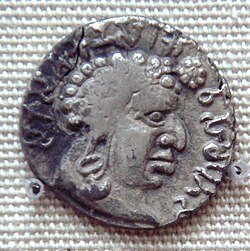| Shivaskanda Satakarni | |
|---|---|
| Satavahana King | |
| Reign | 2nd century CE |
| Predecessor | Vashishtiputra Satakarni |
| Successor | Yajna Sri Satakarni |
| Dynasty | Satavahana |
| Satavahana kings 100 BCE–2nd c. CE | ||||||||||||||||||||||
|---|---|---|---|---|---|---|---|---|---|---|---|---|---|---|---|---|---|---|---|---|---|---|
| ||||||||||||||||||||||
Shivaskanda Satakarni was one of the last rulers of the Satavahana dynasty in India. He succeeded Vashishtiputra Satakarni in 145 CE. His reign is dated variously: 154-161 CE, [1] or 145-152 CE. [2]
He was defeated twice in battle by his Western Satrap enemy Rudradaman. [3]

